As waves of school closings and concert cancellations swept the nation this past March, the CMN member listserv lit up with urgent questions about What to Do. Of course, the community responded by discovering ways to exploit technology and ingenuity so they could temporarily replace the irreplaceable experience of live music making. And the community was just as quick to share tips, ideas, updates, how-tos, and all manner of help for each other.
I asked some folks to share their Music in the Time of Corona wisdom with the PIO! readership. Here are four short articles about making the most of the tools available to keep up those vital connections with children and families. —Ed.
Facing Up to Facebook Live
by Joanie Calem
Long, long ago, in a previous lifetime, when I worked as a Jewish-Arab community worker and not a musician/music teacher, I had terrible stage fright. I had always played music, but for myself. When I became a music teacher, I would get super nervous before every class, which basically meant that I wasn’t sleeping any night of the week. At some point, something switched—I was so exhausted it had to—and I stopped worrying about doing everything according to my own strictly enforced standard of perfection. I started having fun with my music teaching. A few years later, I read an interview with Arlo Guthrie in Sing Out! magazine about his experience of performing with Pete Seeger and learning to overcome stage fright. Arlo related how Pete approached every audience as though he knew ahead of time that they were all friends, just friends that he hadn’t met yet. He was warm and relaxed; he invited them to have fun with him; and of course, as we all know well, he always invited people to sing along. This was the epiphany that I had been waiting for! Ever since reading that article, I have truly adopted that approach to live performing, and though I do occasionally still have stage fright, it is usually the butterflies of anticipation rather than the dragons of dread.
Enter March 2020, and the age of COVID-19. At first, I was as boggled as everyone else about what to do, watching every day of my life empty out of all of my classes, lessons, workshops, conferences, and performances. But I quickly realized, Oh, right, we are not at all isolated anymore. We are required to stay home and physically distance, but we really don’t have to socially distance, because we’ve got What’s App and Facebook and Messenger and Google Hangouts and Zoom and Microsoft Teams and . . . what have I forgotten? We have all these different ways to connect live with friends around the world. Imagine if COVID-19 were happening pre-Internet. That would have felt like isolation.
After the 2016 election, I had participated in a number of concerts put together on a Jewish Facebook Live page called “Harmony in Unison.” I am not a well-known name and I knew that I wasn’t a big pull, not someone that people would see an ad for and make time to hear. But I remembered what Arlo had said about Pete, and I put that to use in the world of Facebook Live: you don’t know who is out there, and you’re not interacting the way you would with an audience that you can see, but you can certainly assume that anyone watching is a friend—perhaps a friend that you haven’t met yet.
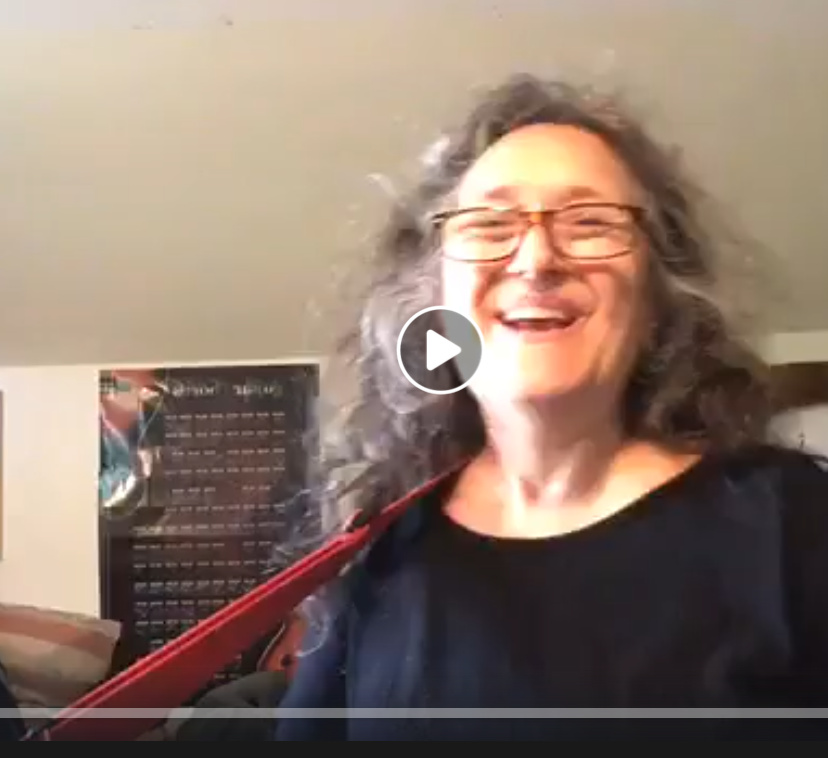 Joanie performing on Facebook Live
Joanie performing on Facebook Live
And indeed, all of those Facebook Live concerts were a blast, and I did make new friends.
So, fast-forward to March 2020. On the day that every one of my regular weekly preschools contacted me to say they had shut their doors (i.e., the day that the governor of Ohio announced that preschools and child care centers had to close along with K-12 schools), I contacted the directors of my various schools and sent out a notice to my mailing list that I would be doing weekly Facebook Live concerts. There was an inrushing of gratitude, and I realized once again the incredible value of the work we do. The kids who were used to seeing me once a week are still seeing me once a week. Many of them are now watching with their parents, who were never before present in my classes because they were at work while their children and I were at school. The songs that I would have been singing in classrooms, I am singing online. The suggestions for additions for zipper songs that I would have been soliciting, I can still solicit, and I get the answers viewers swiftly type into the comments. At the end, we all use the comments to say farewell until next week.
I know that many artists have created tip jars and memberships so that people can only see the show if they have paid. I honestly don’t know the technical way to do that, but I hear colleagues saying that they are doing very well financially with their online concerts. I admit that I am squeamish about asking for money in that manner, so I haven’t, but every week, a few parents do choose to pay me.
The only thing that is challenging for me is making sure that I sing an entire song without getting distracted by the conversations happening in the chat. I liken this to live performances when kids and parents are talking in the midst of a song: I have to really focus to keep the song going. I have learned how to do that in live performances, so I hope that I will get better on FB as well.
Other than that small thing, I find doing FB Live concerts one of the silver linings of this period, and really enjoyable. Though I can’t see my audience, I know they are out there, and it sure seems like they are having fun and are glad that I am doing this. I am able to maintain a presence with the children and families that I have the joy of spending time with every week, even when we can’t be together physically. I am thrilled that some friends have found ways to monetize their FB Live concerts, and happy that people are paying them and continuing to value the arts and music during this odd time we are living in.
So, if you are a performer who has a Facebook page, and you haven’t done a FB Live concert yet, I encourage you to give it a try. I bet you will have a blast!
At Home With Sponsored Concerts
by Susan Salidor
A week into the stay-at-home order, I’d already performed a handful of free morning concerts and classes on Facebook Live. I’d begun asking for tips or donations, and I’d set up a special URL with my name on my PayPal account to make tipping easier. I also created a Venmo account with the encouragement of my twenty-seven-year-old daughter Hannah, who thought it would be the platform of choice for the parents of my preschool students. (She was right: Parents who tip usually choose Venmo.) I have also offered free Happy Birthday videos to children who will not be celebrating birthdays with classmates. I’ve recorded and sent about twenty of these, and a few parents have tipped me.
I was delighted when I began to receive tips, since I had no expectations, and the reality of lost wages was just beginning to take hold. Hannah created a lovely graphic, which I began using immediately to promote the daily show, titled “Songs of Comfort and Joy.” Although I am grateful, the tips do not begin to make up for my lost income.
Side note: After the 2008 recession, I turned my career in children’s music toward more teaching when concert bookings started to lag; libraries and children’s museums, for example, began to use in-house employees for their music programs. I was fortunate to find preschools that believed in the importance of quality music and movement for their students. The regular paycheck (September to May) and not having to hustle for concert work were welcomed changes. It’s also been great to be on the same schedule as my husband, a high school English teacher who is off in the summer.
It became clear I needed to at least try to generate more income, so I created an extra Friday Family Concert that would be sponsored by able and willing families. I had no idea if this would work, but I started asking for sponsors on my morning show and posting sponsor requests on Facebook (FB), which is the platform I use for reaching out to families.
Another side note: A few months ago, Hannah began helping me grow my professional page on FB, driving families and fans to that page instead of my regular Facebook account. With her help, we’ve doubled the number of people who Like and Follow my work there.
I came up with a reasonable plan that would require eight families to pledge $25 each. This meant I would earn $200 for a forty-five minute concert once a week. (This is far below what I would charge for an in-person concert, but hey—I didn’t have to leave the house!) Families stepped up, and Hannah created a second poster that lists the families and can be changed weekly as sponsors change.
To date, I’ve performed three Friday Family Concerts. These concerts are free and open to the public via FB Live, as are the daily 11:00 a.m. shows, but the family sponsors are acknowledged and thanked personally. My hope is that the families feel good about helping to provide more music for young children who are homebound.
We are going into week five of staying home in Chicago, and I will once again announce the Friday concert and ask for sponsors. I am also thinking of offering music classes for a fee to families, now that I have officially been laid off by my schools. I have been following the efforts of fellow CMNers in this regard, deciding which platform is best, how many families to include in one class, and so on. I’m hoping to promote these private music classes in the next few days.
If you choose to follow my example of sponsored concerts, you will need to promote them and the opportunity for sponsorship constantly. This did not come easily to me as I have limited brain capacity for business things. I’m much more interested in composing and performing and enjoying the company of young children and their amazing teacher. I remain grateful for the virtual company of CMNers and their generosity of spirit in all things. Good luck to us all as we navigate the unknown.
Making Videos During Sheltering Times
by Valerie Leonhart Smalkin
In normal times, I would have started with lighting, lighting, and lighting! But I’m learning that there are no real rules for anything in these sheltering times. There is no right or wrong way to make a video. One of my favorites was made by Grand Maloy Smith, with a flashlight in his closet, “Waiting for the Good Old Days Again.” Or here’s another, with creative lighting by Fred McNaughton: “What’s Your Superpower?”
So, my new No. 1 rule is CONTENT. Or, as Steve Martin said, “Be so good they can’t ignore you.” Ask yourself: Is it a good song? Do I have valuable information to share? If not, wait.
My No. 2 rule is CONNECTION. It really doesn’t matter too much what you look or sound like in these sheltering times. It’s the connection you make with your viewer. You really must pretend there are people on the other side of the camera and talk to them, share with them, and get personal.
Still, even with great content and connection, the technical details—camera, sound, and lighting—do need to be in order.
Camera
My long-time TV producer, Pete O’Neal Sr., and his talented son, Pete O’Neal Jr., tell me that after years of carrying around heavy cameras for the local news stations they now often use—ready? An iPhone. If it’s good enough for them, it’s good enough for me. Also, if you must use the laptop or computer built-in camera, there are inexpensive webcam settings apps that let you adjust brightness, white balance, contrast, saturation, and more. Here’s the Apple Webcam Settings app.
Sound
Sound quality does make a difference. I want clear, non-tinny, non-hummy, warm vocals, please! Here are the simple ways to accomplish that goal.
First, use the iPhone and be close to it when you record. In order to be looking straight down the barrel at the viewer, I position the iPhone in the non-selfie mode so that I cannot see the display. That way I look at the camera lens, and not myself, and avoid appearing to the viewer like I am not looking at them. (Again, in the COVID-19 era, that might not make a difference. People are accustomed to conversing via video conference with each person looking past the other.) When I cannot see the display, I make sure I know where the edges of the video frame are, and I stay inside that imaginary frame or stage. Also—and this is a tad tricky—when you are recording with the non-display side facing you, you will want to go to Settings, select Camera and then select Record Stereo Sound so that your camera records from the mic on the same side as the camera lens. Conversely, if you are recording from the selfie side, where you can see the display, deselect Record Stereo Sound so that your iPhone uses the mic on the display side.
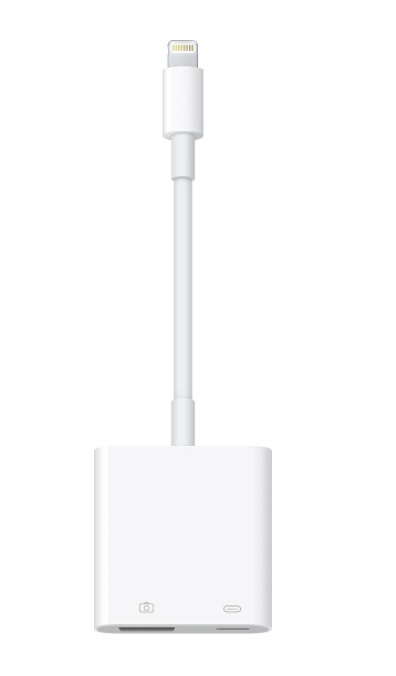 Apple’s USB 3 Camera Adapter
Apple’s USB 3 Camera Adapter
Second, connect your studio recording microphone to your iPhone. This is a little trickier because while your audio interface to your computer connects to a plain old USB slot, the iPhone does not have a USB slot, so you need an adapter. I use Apple’s Lightning to USB 3 Camera Adapter (Figure 1) to connect my Tascam US-16x08 USB Audio/MIDI Interface to my iPhone while recording. You do have to check which version of USB slot you have, an older version or the latest. There are also products that claim to connect any mic to the iPhone, but I have heard some horror stories along with the success stories. So, I just go with what Apple provides.
Finally, if none of this paragraph makes any sense to you, go back to the first option: use the iPhone and be close to it when you record.
Lighting
Lighting, whether straightforward or creative, really is vital. I tend to like a good deal of light under my face. I was pretty pleased with my lighting in this video:
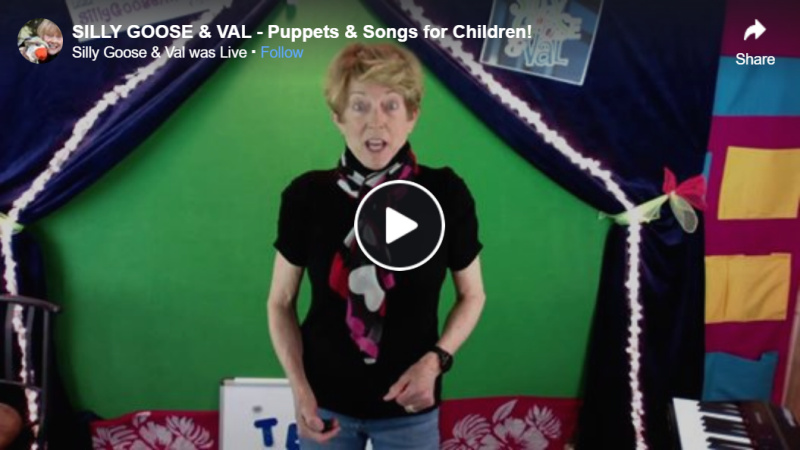 Video: Silly Goose & Val Live.
Video: Silly Goose & Val Live.
The quality of the video is poor because it was a Facebook Livestream. Compare the quality of that video to one filmed, edited, and then uploaded:
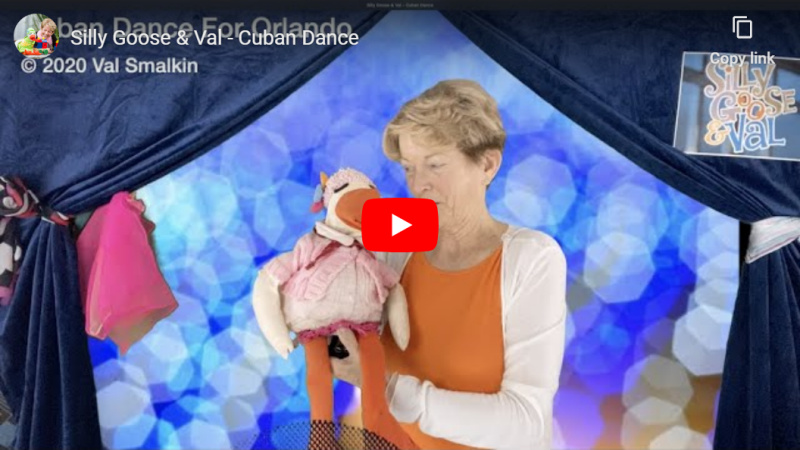 Video: Silly Goose & Val Cuban Dance
Video: Silly Goose & Val Cuban Dance
In both cases, the lighting is far from perfect, but it’s not terrible either! Here’s a picture of the lighting I used for “Silly Goose & Val Live.” I put scarves over all the lights because the lighting gets too white.
 Pano picture of lighting setup from performer’s point of view
Pano picture of lighting setup from performer’s point of view
The higher Lights 2 and 3 light up the front of me. Light 1 and 4 light up the wall behind me so that my shadow is not too visible. And Light 5 (bottom center) is my “look younger” light, filling in my eye bags. Robert Strong tells me that I should put Light 5 to the right or left of me creating a slight shadow and adding depth to the picture. Which should you go for? Depth or the absence of eye bags? Your choice.
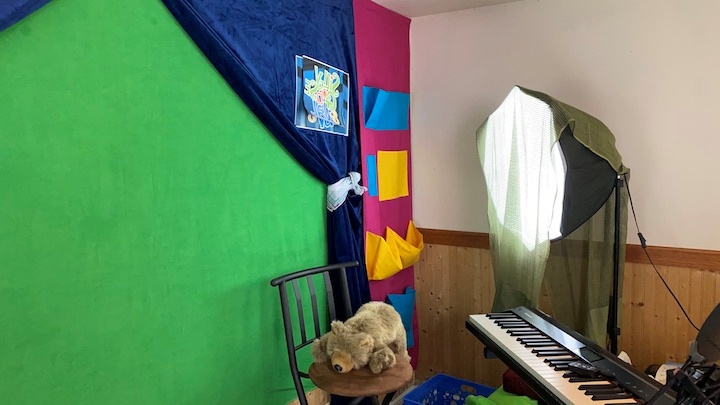 Lighting up the wall behind the performer
Lighting up the wall behind the performer
Here is how it looks from a bug on the ceiling’s point of view. This setup is particularly important for green screen work.
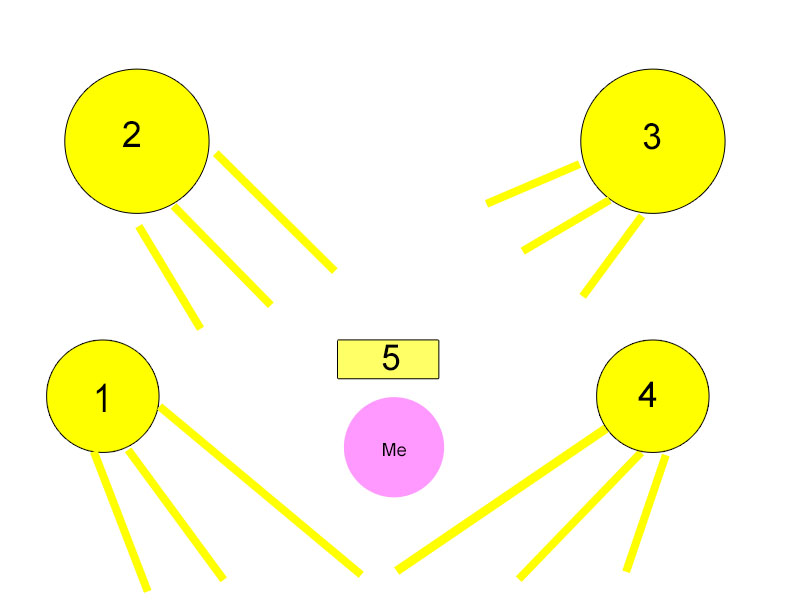 Floor plan of lighting layout
Floor plan of lighting layout
And the result! A nice clear picture without too many shadows!
 Final result
Final result
Or, you can just go outside under a tree on a sunny day. That’s the best lighting ever.
If you want to know more, I strongly recommend watching Marlene Hielema’s Video Expertise for Teachers and Bloggers. She has a great video on lighting and another video on white balance.
Happy videoing!
Fair Use and Distance Learning
by Lisa Heintz
Recently, I noticed an unusual uptick in the number of messages my online business, Little Songbird: Songs for Learning, was receiving. It seemed that pre-K through grade 3 educators are anxious for guidance and clarification regarding the use of copyrighted material (i.e., children’s music purchased from Little Songbird) on the Internet now that they are expected to begin distance learning quickly and without much preparation or experience.
“May I please post this song on Zoom for my students? I need to know by NOON TODAY!”
“Is it legal for me to share these songs with my students now that my school district is switching to distance learning?”
“I want to use the songs we’ve been singing in school to keep it as familiar for my students as possible, and I start online tomorrow. Is it OK for me to share the songs I got here?!”
As an early childhood educator turned “edu-preneur,” I know how important music is to everyday curriculum. It is the goal of Little Songbird to serve the education community by providing quality children’s music that can be incorporated into the general curriculum. So, it seems natural to want to assist these frantic teachers who were trying to do the right thing by seeking permission to use the songs they needed for their work.
Here’s the kicker: The technical answer to all those earnest questions may actually be NO.
Not because I don’t want to support educators; they are my business’s target audience. But fair use (the principle that copyrighted material may be reproduced without permission if the use meets certain criteria) has been associated with several myths about its interpretation. In short, as a vendor, I have no right to grant such permission to anyone, even under the most reasonable circumstances.
After first considering the overwhelming nature of what was happening for educators, students, families, and artists, my next thought was that the sudden launch from classroom to online platforms could be a boon to artists as their work was utilized in more public formats, and teachers would share their favorite artist’s songs, dances, and books with fellow struggling teachers “out there in cyberspace.” At a time when artists struggle to be heard, or receive living wages for their music, the idea seemed encouraging.
My initial plan was to respond quickly by creating a convenient blanket temporary and limited agreement that clearly stated the parameters for permission to use and post songs:
Who: Only the single purchaser
What: Only songs purchased through our site
When: Through June 2020 to allow all schools to complete their academic year
Where: In-person or online classrooms
How: By signing and returning an agreement and promising to remove the music from all platforms by the deadline
To accomplish this, I would also need to create an opt-in agreement for artists to sign, allowing their work to be used online in these new and unexpected ways. I’d also need to create a list of artists who had opted in and what specific songs or albums they were willing to share in this manner.
Almost instantly, I realized the potential for chaos, errors, and the further loss of control over their own work my talented artist-colleagues might experience. After consulting with several of them, it became evident that many valued maintaining control over their music more than potential exposure or fan-base growth. While some were pragmatic about the nature of online music use today and were open to my proposal, in the end I felt it was wisest to continue to gather input from my colleagues before bursting onto the distance learning scene as quickly as the teachers.
Despite my temporary retreat, I believe this is a pivotal moment for educating the educators regarding fair use, copyright, and the more recent Technology, Education, and Copyright Harmonization Act (T.E.A.C.H.) of 2002, which enables public school educators to move their lawfully obtained teaching materials from face-to-face classrooms to online video conference platforms. I now readily share my Fair Use & Clarification graphic* as well as a TEACH Checklist*, and ask each enquirer to reach out directly to the artists/authors whose work they wish to use in order to get permission to do so. For now, this seems to be the most direct and fair way to manage music requests, though I am still entertaining other artist-friendly and teacher-friendly options.
With thousands of sites removing paywalls from content to make it more accessible during this period of online teaching, the sea of copyrighted material has grown exponentially in just the past month. So how do we, who are tasked with providing quality content for online learners, navigate these ever-shifting waters? As content creators, what should you allow educators to use in their work online? As educators, what is permissible to use? How? For how long?
However you use music with children online, the best plan is to educate yourself about the laws and acts intended to support artists and authors (copyright law) and those that support educators (fair use, TEACH). Artists, learn as much as you can about the intent of content use as well as the intent of the protections afforded school teachers online. Seize this time as a “teachable moment” to both encourage educators to use your work as part of their daily online curriculum and educate them on how it can be done wisely and fairly for all involved. Educators, learn as much as you can about content publishing online as it pertains to the work you want to use, and about the importance of the limitations in place to protect the creators of the work you appreciate enough to want to share with students and parents. These rules can be mutually beneficial if you understand how to employ them reasonably and fairly.
*Note that these documents were created only as a guide for appropriate use of copyrighted material and do not represent, provide, or replace legal advice in any way.